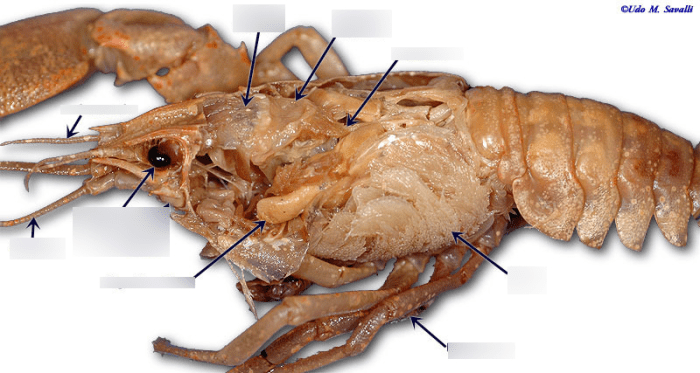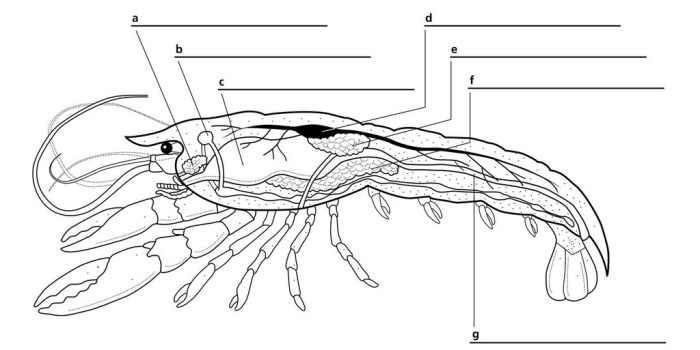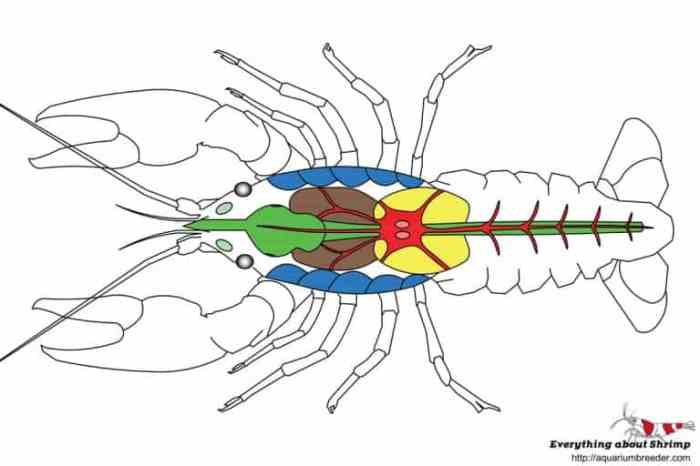Embarking on an in-depth exploration of the internal anatomy of a crayfish, we unravel the intricacies of this fascinating creature’s biological makeup. From its digestive system to its reproductive mechanisms, each organ and system plays a vital role in the crayfish’s survival and well-being.
Delving into the crayfish’s internal architecture, we discover a symphony of specialized organs working in harmony. The digestive system, circulatory system, respiratory system, nervous system, reproductive system, excretory system, and more, each with its unique function, contribute to the crayfish’s ability to navigate its aquatic environment.
Internal Anatomy of a Crayfish

Crayfish possess a complex internal anatomy that enables them to thrive in their aquatic environments. Their internal organs are organized into specialized systems, each performing distinct functions essential for the crayfish’s survival and well-being.
Digestive System
The digestive system of a crayfish is responsible for breaking down food and extracting nutrients. It begins with the mouth, which leads to a short esophagus and a large, muscular stomach. The stomach is divided into two chambers: the cardiac stomach, which grinds food, and the pyloric stomach, which filters and passes food into the intestine.
The internal anatomy of a crayfish is quite complex, with various organs and systems working together to sustain the creature. For those interested in delving deeper into the intricacies of legal matters, the nys notary practice exam free provides valuable insights into the practical aspects of notarization.
Returning to the crayfish’s internal anatomy, the digestive system plays a crucial role in processing food, while the circulatory system ensures the distribution of nutrients and oxygen throughout the body.
The intestine is a long, coiled tube that absorbs nutrients from food. Waste products are stored in the rectum and expelled through the anus.
Circulatory System
The circulatory system of a crayfish is open, meaning that blood is not confined to vessels but instead flows freely through the body cavity. The heart is a small, triangular organ located in the pericardial sinus, a cavity in the thorax.
The heart pumps blood through arteries into sinuses, which are large spaces in the body cavity. Blood then flows through the gills, where it picks up oxygen, and returns to the heart through veins.
Respiratory System
The respiratory system of a crayfish consists of gills, which are feathery structures located on the sides of the thorax. Water is drawn in through the mouth and passes over the gills, where oxygen is absorbed into the blood. Carbon dioxide is released into the water through the gills.
Nervous System
The nervous system of a crayfish is composed of a brain, ventral nerve cord, and peripheral nerves. The brain is located in the head and controls the crayfish’s senses, movement, and behavior. The ventral nerve cord runs along the underside of the body and connects to peripheral nerves that extend to all parts of the body.
Reproductive System, Internal anatomy of a crayfish
The reproductive system of a crayfish varies depending on the sex of the individual. Male crayfish have a pair of testes located in the thorax. Female crayfish have a pair of ovaries located in the abdomen. Both males and females have a pair of reproductive ducts that lead to a single opening on the ventral side of the body.
Digestive System

The digestive system of a crayfish is a complex network of organs responsible for breaking down and absorbing nutrients from food. It consists of several key components, including the esophagus, stomach, intestine, and hepatopancreas.The esophagus is a short, muscular tube that connects the mouth to the stomach.
It helps to transport food to the stomach by peristalsis, a series of rhythmic contractions. The stomach is a J-shaped organ that secretes digestive enzymes and grinds food into smaller particles. The intestine is a long, coiled tube that absorbs nutrients from the food.
The hepatopancreas is a large, bilobed organ that produces digestive enzymes and absorbs nutrients.The process of digestion in a crayfish begins with the ingestion of food. The food is then transported to the stomach, where it is mixed with digestive enzymes and ground into smaller particles.
The partially digested food then moves into the intestine, where nutrients are absorbed into the bloodstream. The remaining waste products are expelled through the anus.
Circulatory System: Internal Anatomy Of A Crayfish

The circulatory system of a crayfish is an open circulatory system, meaning that the blood is not confined to vessels but instead flows freely through the body cavity.
The heart is a small, sac-like organ located in the pericardial sinus, a space in the dorsal part of the cephalothorax. The heart has three chambers: two atria and one ventricle. The atria receive blood from the body, and the ventricle pumps the blood out to the body.
The blood vessels are not well-defined in a crayfish. Instead, the blood flows through a network of sinuses, which are spaces between the organs. The sinuses are lined with a thin layer of cells that help to regulate the flow of blood.
The hemolymph is the fluid that circulates through the circulatory system. It is similar to blood in humans, but it does not contain any red blood cells. The hemolymph carries nutrients, oxygen, and waste products throughout the body.
Blood Circulation
The blood is circulated throughout the body by the heart. The heart pumps the blood out of the ventricle into the sinuses. The blood then flows through the sinuses and back to the heart through the atria.
The circulation of the blood is important for the crayfish because it allows the nutrients, oxygen, and waste products to be transported throughout the body.
Respiratory System

The respiratory system of a crayfish is designed to facilitate the exchange of gases between the body and the surrounding environment. It consists of two primary structures: gills and branchiostegites.Gills are feathery structures located on the sides of the crayfish’s body, within the branchial chambers.
Each gill is composed of a central axis with numerous thin filaments, which increase the surface area for gas exchange. The filaments are covered in a thin membrane that allows oxygen and carbon dioxide to pass through.Branchiostegites are thin, plate-like structures that cover the gills.
They provide protection for the delicate gills and create a flow of water over them. The water enters the branchial chambers through an opening at the front of the body and exits through an opening at the back.As water flows over the gills, oxygen from the water diffuses across the thin membrane of the filaments and into the bloodstream.
At the same time, carbon dioxide, a waste product of cellular respiration, diffuses out of the bloodstream and into the water. This exchange of gases ensures that the crayfish’s body receives a constant supply of oxygen and eliminates waste products.
Nervous System

The nervous system of a crayfish is responsible for coordinating the activities of the animal’s body. It consists of a brain, a ventral nerve cord, and ganglia.
The brain is located in the head of the crayfish and is responsible for processing sensory information and controlling movement. The ventral nerve cord runs along the underside of the body and connects the brain to the ganglia, which are clusters of nerve cells that control specific body functions.
Sensory Organs
Crayfish have a variety of sensory organs that allow them to detect changes in their environment. These organs include:
- Eyes: Crayfish have compound eyes that are located on stalks on either side of the head. These eyes allow crayfish to see in all directions and to detect movement.
- Antennae: Crayfish have two pairs of antennae that are located on the front of the head. These antennae are used to detect chemicals in the water and to touch objects.
- Statocysts: Crayfish have statocysts that are located on the underside of the body. These organs help crayfish to maintain their balance.
Motor Responses
The nervous system of a crayfish controls the animal’s motor responses. These responses include:
- Walking: Crayfish walk by using their five pairs of legs. The nervous system coordinates the movement of these legs to allow the crayfish to move forward, backward, and sideways.
- Swimming: Crayfish can swim by using their tail fan. The nervous system coordinates the movement of the tail fan to allow the crayfish to swim forward and backward.
- Feeding: Crayfish use their claws to capture and eat food. The nervous system coordinates the movement of the claws to allow the crayfish to grasp and crush food.
Excretory System

The excretory system of a crayfish plays a vital role in eliminating waste products from the body. It comprises two main structures: the antennal glands and nephridia.
Antennal Glands
The antennal glands are located at the base of the antennae. They function as kidneys, filtering waste products from the blood and producing urine. The urine is then transported through ducts to the exterior of the body.
Nephridia
Nephridia are numerous, small, tubular structures scattered throughout the body. They collect waste products from the surrounding tissues and transport them to the exterior through small pores on the body surface.
Together, the antennal glands and nephridia work to maintain the proper internal environment of the crayfish by removing harmful waste products and regulating the balance of fluids and electrolytes in the body.
FAQ Corner
What is the function of the hepatopancreas in a crayfish?
The hepatopancreas is responsible for producing digestive enzymes and absorbing nutrients from food.
How does a crayfish breathe?
Crayfish breathe through gills located on their thorax.
What is the role of the nervous system in a crayfish?
The nervous system controls the crayfish’s behavior, senses, and movement.